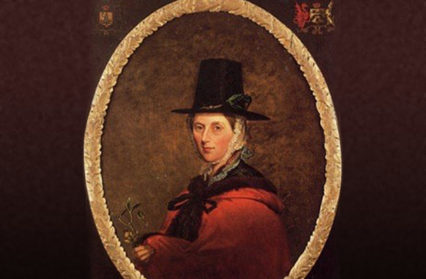The history of the Welsh National Dress is well-marked. Encouraged by Lady Llanover of Gwent, the wearing of the National Dress was intended to serve as a rebuke to a perceived loss of national identity. The dress, despite its impracticalities, was designed then to serve as a pointed reminder of a very clear and separate identity for Welsh nationals.
It is telling then, that this mode of dress, one originally intended as a distinctive mark of national pride and identity, has seen its use subverted. While the dress is still celebrated in Wales, with schoolchildren encouraged to dress up on St David’s Day, the dress, when viewed through the lens of the nationality of Britain, immediately conjures characters whose very national identity becomes a projection for comedic purposes.
The dress, particularly the women’s national dress, has, for some, become synonymous with the very specific stereotypes so often associated with Wales: a lack of progression, an inward focus, with a lack of awareness of anything outside of a localised geographical location.
Beddoe notes that the Welsh Dress, in its original incarnation, was intended to be used as a device of tourism. Created at a time when the ‘old peasant costume was dying out’, the dress was, as Beddoe marks, decorous and as such, was difficult to work in. It is worth highlighting this apparent original intention in that the dress is ar
mpact upon its audience. dic rochrial ales, but rather the manner he dress is arguably used for the same reasoning today.o be cguably used for the same reasoning today. Not necessarily by those resident in Wales, but rather the manner in which it is presented by the media. The use of the dress is perceived as something almost antiquated, and parochial. Something to be indulged in. Its intentional usage often timed to create a comedic impact upon its audience.
Arguably this concept of the Welsh National Dress is one that has become increasingly abstract, but ever present. Thus, while the dress itself may not be included, a character’s adherence and steadfast pride and belief in the value of Wales above all else is widely held up for mockery. The dress then, while not necessarily a physical incarnation of Lady Llanover’s creation, still exists, rendered as something very tangible and real in a character’s assertion and declaration of a specific geographical location holding dominion.
It is there in Stacey’s continued pontificating as regards the value of Barry in the stupefyingly popular Gavin and Stacey. It is not Stacey’s unquestionable regard for Barry that is problematic, but rather the manner in which this affection is treated by others. Gavin is frequently disdainful, heralding Stacey’s devotion as questionable. Given that Stacey is regularly highlighted as being less intelligent, and often simplistic in her approach and understanding of concepts, her love of Barry is immediately questioned. This, when coupled with the depiction of Gavin as more reliable and mature, creates a reductive notion.
Stacey, in sending Gavin property in Barry which is within their budget, is roundly rejected, with the implication being that Barry’s low property pricing is in line with its lack of desirous location. Gavin, despite eventually moving to Barry with Stacey, never truly aligns himself with the area, and its continued othering (with the Owain Hughes joke, and the statement by Smithy that no one speaks Welsh in the area) is clearly intended to question Stacey’s continued link to the area.
Indeed, her assertion of missing the place in which she grew up, the place within which she first formed her identity, is consistently questioned by Gavin, and there is a sense that he has only allowed the move to Barry to placate Stacey. He never attempts to discuss, or uncover her emotional ties to the area.
Similarly, The Valleys, the deservedly much-maligned MTV series while ostensibly not explicitly heralding its women as Welsh, does so through the very creation of the series. Following the trend of such scripted reality series, the show focuses on a range of extreme stereotypes. While different from series such as Gavin and Stacey in the sense that they are, purportedly, a depiction of reality, the clear scripting element arguably renders series such as The Valleys as constructed as any fictive creation. In fact, the very fact that the series supposedly imitates reality is more damaging for the viewer, who when watching the series, is encouraged to believe that they are watching real life.
For the cast, their very national identity is intentionally, and specifically, brought to the viewer’s attention. These women then, through their very Welshness, so purposefully highlighted by the central conceit of the series, are presented as if in a form of national dress. This, when combined with the encouraged viewer voyeurism when viewing their various exploits, rather reductively compels the viewer to once again, other the women onscreen. For the viewer, there is almost some comfort in the thought that these women, so questionable in their activities and misdemeanours, are entirely unlike them.
What then does this suggest about the very national identity of these women? Stacey’s continued, unconditional love for Barry marks her as unintelligent and immature, while the women in The Valleys, so explicitly Welsh, are reduced to figures of derision and scorn. Seemingly then, any sense of national pride, or unhindered national identity, is quite intentionally held up for ridicule and contempt. These women, lacking in any sense of multifaceted depiction, are marked by their very Welshness, and in turn, made questionable. While Beddoe’s highlighted the use of national dress as a means for tourism, here, and too frequently, it is used to once again, isolate and contain identity.











